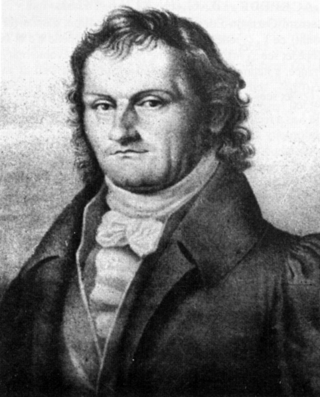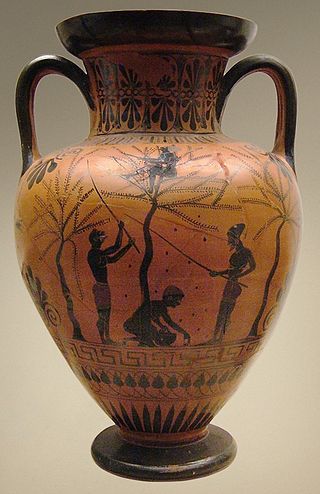Related Research Articles
Didymus Chalcenterus, was an Ancient Greek scholar and grammarian who flourished in the time of Cicero and Augustus.

Joannes Stobaeus, from Stobi in Macedonia, was the compiler of a valuable series of extracts from Greek authors. The work was originally divided into two volumes containing two books each. The two volumes became separated in the manuscript tradition, and the first volume became known as the Extracts and the second volume became known as the Anthology. Modern editions now refer to both volumes as the Anthology. The Anthology contains extracts from hundreds of writers, especially poets, historians, orators, philosophers and physicians. The subjects range from natural philosophy, dialectics, and ethics, to politics, economics, and maxims of practical wisdom. The work preserves fragments of many authors and works which otherwise might be unknown today.
Gaius Julius Hyginus was a Latin author, a pupil of the scholar Alexander Polyhistor, and a freedman of Caesar Augustus. He was elected superintendent of the Palatine library by Augustus according to Suetonius' De Grammaticis, 20. It is not clear whether Hyginus was a native of the Iberian Peninsula or of Alexandria.

Eunapius was a Greek sophist, rhetorician, and historian from Sardis in the region of Lydia in Asia Minor of the fourth century AD. His principal surviving work is the Lives of Philosophers and Sophists, a collection of the biographies of 23 philosophers and sophists. The exact date of his death is unknown but speculated sometime after 414 AD during the reign of Theodosius II

Johann Gottlob Theaenus Schneider was a German classicist and naturalist.
Stephanus or Stephen of Byzantium, was a Byzantine grammarian and the author of an important geographical dictionary entitled Ethnica (Ἐθνικά). Only meagre fragments of the dictionary survive, but the epitome is extant, compiled by one Hermolaus, not otherwise identified.
Quintus Remmius Palaemon or Quintus Rhemnius Fannius Palaemon was a Roman grammarian and a native of Vicentia. He lived during the reigns of Emperors Tiberius and Claudius.
Marcus Terentius Varro was a Roman polymath and a prolific author. He is regarded as ancient Rome's greatest scholar, and was described by Petrarch as "the third great light of Rome". He is sometimes called Varro Reatinus to distinguish him from his younger contemporary Varro Atacinus.
Censorinus was a Roman grammarian and miscellaneous writer from the 3rd century AD.
Rutilius Taurus Aemilianus Palladius, also known as Palladius Rutilius Taurus Aemilianus or most often just as Palladius, was an ancient writer who wrote in Latin, and is dated variously to the later 4th century or first half of the 5th century AD. He is principally known for his book on agriculture, Opus agriculturae, sometimes known as De re rustica.
Eutropius, scholarly abbreviated Eutr., Eutr. Brev. or Eutrop., was a Roman official and historian. His book Breviarium Historiae Romanae summarizes events from the founding of Rome in the 8th century BC down to the author's lifetime. Appreciated by later generations for its clear presentation and writing style, the Breviarium can be used as a supplement to more comprehensive Roman historical texts which have survived in fragmentary condition.
The Geoponica or Geoponika is a twenty-book collection of agricultural lore, compiled during the 10th century in Constantinople for the Byzantine emperor Constantine VII Porphyrogenitus. The Greek word Geoponica signifies "agricultural pursuits" in its widest sense. It is the only surviving Byzantine agricultural work.
Dositheus Magister was a Greek grammarian who flourished in Rome in the 4th century AD.
Geoponici, or Scriptores rei rusticae, is a collective term for the Greek and Latin writers on husbandry and agriculture. In classical times it was regarded as a branch of economics.

Agriculture was the foundation of the Ancient Greek economy. Nearly 80% of the population was involved in this activity.
Cassius Dionysius of Utica was an ancient Greek agricultural writer of the 2nd century BC. The Roman nomen, Cassius, combined with the Greek cognomen, Dionysius, make it likely that he was a slave, originally Greek-speaking, who was owned and afterwards freed by a Roman of the gens Cassia. Cassius Dionysius compiled a farming manual in Greek, now lost. Its title was Georgika ("Agriculture"); it was divided into twenty books, and was dedicated by its author to the Roman praetor Sextilius.
Diophanes of Nicaea or Diophanes the Bithynian was a Greek agricultural writer of the 1st century BC. He was a native of or associated with the city of Nicaea in Bithynia.
Vindonius Anatolius Berytius was a Greek author of the 4th century in Lebanon. He may be identical with the praetorian prefect of Illyricum mentioned by Ammianus Marcellinus.
Ibn al-'Awwam, also called Abu Zakariya Ibn al-Awwam, was a Muslim Arab agriculturist who flourished at Seville in the later 12th century. He wrote a lengthy handbook on agriculture entitled in Arabic Kitāb al-Filāḥa, which is the most comprehensive treatment of the subject in medieval Arabic, and one of the most important medieval works on the subject in any language. It was published in Spanish and French translations in the 19th century. The edition in French is about 1350 pages.
Ibn Bassal was an 11th-century Andalusian Arab botanist and agronomist in Toledo and Seville, Spain who wrote about horticulture and arboriculture. He is best known for his book on agronomy, the Dīwān al-filāha.
References
- Wilhelm Gemoll in Berliner Studien, i. (1884)
- Cassianus Bassus, Geoponica: Geoponica sive Cassiani Bassi Scholastici De re rustica eclogae, ed. H. Beckh, Leipzig 1895
- Oder in Rheinisches Museum, xlv. (1890), xlviii. (1893)
- De Raynal in Annuaire de l'Assoc. pour l'Encouragement des Etudes Grecques, viii. (1874).
- This article incorporates text from a publication now in the public domain : Chisholm, Hugh, ed. (1911). "Bassus, Cassianus". Encyclopædia Britannica . Vol. 3 (11th ed.). Cambridge University Press. p. 498.